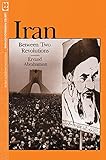Iran Between Two Revolutions / Ervand Abrahamian.
Material type: TextSeries: Princeton Studies on the Near EastPublisher: Princeton, NJ : Princeton University Press, [2021]Copyright date: ©1982Description: 1 online resource (561 p.)Content type:
TextSeries: Princeton Studies on the Near EastPublisher: Princeton, NJ : Princeton University Press, [2021]Copyright date: ©1982Description: 1 online resource (561 p.)Content type: - 9781400844098
- HISTORY / Middle East / General
- Abadan
- Adamiyat, Fereydoun
- Algeria
- Azerbaijan
- Bahrami, Muhammad
- Bakhtiyaris
- Baluchis
- Basseris
- Communist party (1947)
- Cottam, Richard
- Daneshyan, Ghulam
- Dashnak party
- Dawlatabadi, Yahya
- Farah Diba, Empress
- Farangestan
- Fatherland party
- Fayzieh
- Georgians
- Griboyedov
- Hajji Ibrahim
- Haydaris
- Imam Hussein
- Iskandari, Sulayman
- Jahanshalou, Nosratallah
- Jangali party
- Kani, Hojjat al-Islam
- Kayhan
- Kermanshah
- Mahazari, Ibrahim
- Mamasanis
- Nakhshab, Muhammad
- National caucus
- Ovanessian, Ardasher
- Pan-Iranist party
- Peace Partisans
- Qajar tribe
- Qum
- Resurgence party
- Reza’i, Ahmad
- bazaars
- cabinets
- capitulations
- classes
- educational facilities
- electoral laws
- fascism
- gharbzadegi
- income distribution
- industrialization
- land reform
- missionaries
- oil nationalization
- 955.05 19
- DS316.6
- DS316.6
- online - DeGruyter
| Item type | Current library | Call number | URL | Status | Notes | Barcode | |
|---|---|---|---|---|---|---|---|
 eBook
eBook
|
Biblioteca "Angelicum" Pont. Univ. S.Tommaso d'Aquino Nuvola online | online - DeGruyter (Browse shelf(Opens below)) | Online access | Not for loan (Accesso limitato) | Accesso per gli utenti autorizzati / Access for authorized users | (dgr)9781400844098 |
Browsing Biblioteca "Angelicum" Pont. Univ. S.Tommaso d'Aquino shelves, Shelving location: Nuvola online Close shelf browser (Hides shelf browser)

|

|

|

|

|

|

|
||
| online - DeGruyter The Bon Marché : Bourgeois Culture and the Department Store, 1869-1920 / | online - DeGruyter The Gay Archipelago : Sexuality and Nation in Indonesia / | online - DeGruyter The End of the Russian Imperial Army, Volume II : The Road to Soviet Power and Peace / | online - DeGruyter Iran Between Two Revolutions / | online - DeGruyter Poetry of the Revolution : Marx, Manifestos, and the Avant-Gardes / | online - DeGruyter American Babylon : Race and the Struggle for Postwar Oakland / | online - DeGruyter Physical Chemistry from Ostwald to Pauling : The Making of a Science in America / |
Frontmatter -- Contents -- List of Tables and Figure -- Preface -- Introduction -- PART I Historical Background -- ONE The Nineteenth Century -- TWO The Constitutional Revolution -- THREE Reza Shah -- PART II Politics of Social Conflict -- FOUR The Evolving Political System: From Military to Embattled Monarchy -- FIVE The Evolving Political System: From Embattled to Military Monarchy -- SIX The Tudeh Party -- SEVEN Class Bases of the Tudeh -- EIGHT Ethnic Bases of the Tudeh -- PART III Contemporary Iran -- NINE The Politics of Uneven Development -- TEN The Opposition -- ELEVEN The Islamic Revolution -- Conclusion -- Glossary -- Bibliography -- Index
restricted access online access with authorization star
http://purl.org/coar/access_right/c_16ec
Emphasizing the interaction between political organizations and social forces, Ervand Abrahamian discusses Iranian society and politics during the period between the Constitutional Revolution of 1905-1909 and the Islamic Revolution of 1977-1979. Presented here is a study of the emergence of horizontal divisions, or socio-economic classes, in a country with strong vertical divisions based on ethnicity, religious ideology, and regional particularism. Professor Abrahamian focuses on the class and ethnic roots of the major radical movements in the modem era, particularly the constitutional movement of the 1900s, the communist Tudeh party of the 1940s, the nationalist struggle of the early 1950s, and the Islamic upsurgence of the 1970s.In this examination of the social bases of Iranian politics, Professor Abrahamian draws on archives of the British Foreign Office and India Office that have only recently been opened; newspaper, memoirs, and biographies published in Tehran between 1906 and 1980; proceedings of the Iranian Majles and Senate; interviews with retired and active politicians; and pamphlets, books, and periodicals distributed by exiled groups in Europe and North America in the period between 1953 and 1980.Professor Abrahamian explores the impact of socio-economic change on the political structure, especially under the reigns of Reza Shah and Muhammad Reza Shah, and throws fresh light on the significance of the Tudeh party and the failure of the Shah's regime from 1953 to 1978.
Mode of access: Internet via World Wide Web.
In English.
Description based on online resource; title from PDF title page (publisher's Web site, viewed 27. Jan 2023)


